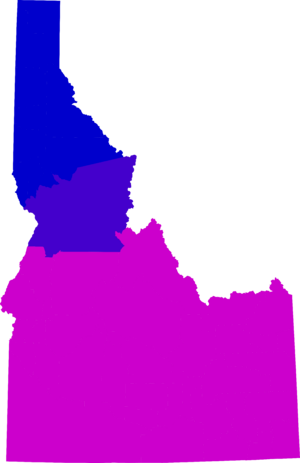List of time offsets by U.S. state and territory facts for kids
Have you ever wondered why the time is different when you call a friend in another state? That's because the United States uses several time zones! A time zone is a region that observes a uniform standard time. This helps keep things organized, especially for travel and communication across the country.
Most U.S. states are entirely within one time zone. However, some larger states, or states with unique geography, might be split into two different time zones. This list will help you understand which time zone each U.S. state, federal district, and territory uses.
Contents
Understanding Time Zones in the U.S.
The U.S. uses several main time zones. Here are the most common ones you'll hear about:
- Eastern Time (ET): This is the easternmost time zone in the mainland U.S.
- Central Time (CT): This zone is one hour behind Eastern Time.
- Mountain Time (MT): This zone is one hour behind Central Time.
- Pacific Time (PT): This is the westernmost time zone in the mainland U.S., one hour behind Mountain Time.
- Alaska Time (AKT): Used in most of Alaska.
- Hawaii-Aleutian Time (HT): Used in Hawaii and parts of Alaska.
Many places in the U.S. also observe Daylight Saving Time (DST). This means that during warmer months, clocks are moved forward by one hour. This gives us more daylight in the evenings. When DST ends, clocks are moved back one hour.
Time Zones by State and Territory
This section lists the time zones for each U.S. state, the federal district, and its territories.
States with One Time Zone
Most states fit entirely into one time zone.
Eastern Time Zone (ET)
These states are in the Eastern Time Zone and observe Daylight Saving Time.
 Connecticut
Connecticut Delaware
Delaware District of Columbia
District of Columbia Georgia
Georgia Maine
Maine Maryland
Maryland Massachusetts
Massachusetts New Hampshire
New Hampshire New Jersey
New Jersey New York
New York North Carolina
North Carolina Ohio
Ohio Pennsylvania
Pennsylvania Rhode Island
Rhode Island South Carolina
South Carolina Vermont
Vermont Virginia
Virginia West Virginia
West Virginia
Central Time Zone (CT)
These states are in the Central Time Zone and observe Daylight Saving Time.
 Alabama (Note: Phenix City often follows Eastern Time unofficially.)
Alabama (Note: Phenix City often follows Eastern Time unofficially.) Arkansas
Arkansas Illinois
Illinois Iowa
Iowa Louisiana
Louisiana Minnesota
Minnesota Mississippi
Mississippi Missouri
Missouri Oklahoma (Note: Kenton often follows Mountain Time unofficially.)
Oklahoma (Note: Kenton often follows Mountain Time unofficially.) Wisconsin
Wisconsin
Mountain Time Zone (MT)
These states are in the Mountain Time Zone and observe Daylight Saving Time.
 Colorado
Colorado Montana
Montana New Mexico
New Mexico Utah
Utah Wyoming
Wyoming Arizona (Note: Arizona generally does not observe Daylight Saving Time, except for the Navajo Nation area.)
Arizona (Note: Arizona generally does not observe Daylight Saving Time, except for the Navajo Nation area.)
Pacific Time Zone (PT)
These states are in the Pacific Time Zone and observe Daylight Saving Time.
States with Multiple Time Zones
Some states are so large or have unique borders that they are split between two time zones.
Alaska
- Most of Alaska uses Alaska Standard Time (AKST).
- The Aleutian Islands (far west) use Hawaii-Aleutian Standard Time (HST).
- Both areas observe Daylight Saving Time.
Florida
- The eastern and southern parts of Florida use Eastern Standard Time (EST).
- The western part of the Florida Panhandle uses Central Standard Time (CST).
- Both areas observe Daylight Saving Time.
Idaho
- Most of Idaho uses Mountain Standard Time (MST).
- The northern part of Idaho, north of the Salmon River, uses Pacific Standard Time (PST).
- Both areas observe Daylight Saving Time.
Indiana
- Most of Indiana uses Eastern Standard Time (EST).
- Small areas in the northwest and southwest corners of the state use Central Standard Time (CST).
- Both areas observe Daylight Saving Time.
Kansas
- Most of Kansas uses Central Standard Time (CST).
- A few western counties (Greeley, Hamilton, Sherman, and Wallace) use Mountain Standard Time (MST).
- Both areas observe Daylight Saving Time.
Kentucky
- The eastern 60% of Kentucky uses Eastern Standard Time (EST).
- The western 40% of Kentucky uses Central Standard Time (CST).
- Both areas observe Daylight Saving Time.
Michigan
- Most of Michigan uses Eastern Standard Time (EST).
- A few counties in the Upper Peninsula that border Wisconsin use Central Standard Time (CST).
- Both areas observe Daylight Saving Time.
Nebraska
- Most of Nebraska uses Central Standard Time (CST).
- The western part of the state, including the Nebraska Panhandle, uses Mountain Standard Time (MST).
- Both areas observe Daylight Saving Time.
Nevada
- Most of Nevada uses Pacific Standard Time (PST).
- The city of West Wendover (on the border with Utah) uses Mountain Standard Time (MST).
- Both areas observe Daylight Saving Time.
North Dakota
- Most of North Dakota uses Central Standard Time (CST).
- Areas west of the Missouri River (with some exceptions) use Mountain Standard Time (MST).
- Both areas observe Daylight Saving Time.
Oregon
- Most of Oregon uses Pacific Standard Time (PST).
- The northern part of Malheur County (in the far east) uses Mountain Standard Time (MST).
- Both areas observe Daylight Saving Time.
South Dakota
- The eastern half of South Dakota uses Central Standard Time (CST).
- The western half of South Dakota uses Mountain Standard Time (MST).
- Both areas observe Daylight Saving Time.
Tennessee
- Most of Tennessee uses Central Standard Time (CST).
- East Tennessee (with a few exceptions) uses Eastern Standard Time (EST).
- Both areas observe Daylight Saving Time.
Texas
- Most of Texas uses Central Standard Time (CST).
- El Paso and Hudspeth counties (in the far west) use Mountain Standard Time (MST).
- Both areas observe Daylight Saving Time.
U.S. Territories and Outlying Islands
These areas have their own time zones, and most do not observe Daylight Saving Time.
 American Samoa: Uses Samoa Standard Time (ST). No DST.
American Samoa: Uses Samoa Standard Time (ST). No DST. Guam: Uses Chamorro Standard Time (ChT). No DST.
Guam: Uses Chamorro Standard Time (ChT). No DST. Hawaii: Uses Hawaii-Aleutian Standard Time (HT). No DST.
Hawaii: Uses Hawaii-Aleutian Standard Time (HT). No DST. Northern Mariana Islands: Uses Chamorro Standard Time (ChT). No DST.
Northern Mariana Islands: Uses Chamorro Standard Time (ChT). No DST. Puerto Rico: Uses Atlantic Standard Time (AT). No DST.
Puerto Rico: Uses Atlantic Standard Time (AT). No DST. Virgin Islands (U.S.): Uses Atlantic Standard Time (AT). No DST.
Virgin Islands (U.S.): Uses Atlantic Standard Time (AT). No DST. U.S. Minor Outlying Islands: These small islands are spread across many different time zones.
U.S. Minor Outlying Islands: These small islands are spread across many different time zones.
- Wake Island: UTC+12:00 (Wake Island Time Zone)
- Baker Island and Howland Island: UTC−12:00
- Jarvis Island, Kingman Reef, Midway Atoll, and Palmyra Atoll: UTC−11:00 (Samoa Time)
- Johnston Atoll: UTC−10:00 (Hawaii-Aleutian Time)
See also
 In Spanish: Anexo:Estados y territorios de Estados Unidos por franjas horarias para niños
In Spanish: Anexo:Estados y territorios de Estados Unidos por franjas horarias para niños
- History of time in the United States
- List of time zones
- Time in the United States








